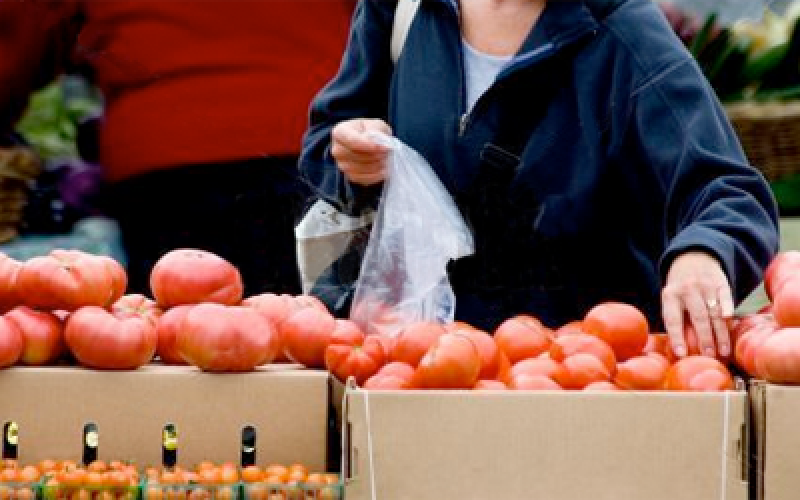Written by Rhoda Burrows, former Professor & SDSU Extension Horticulture Specialist.
Description
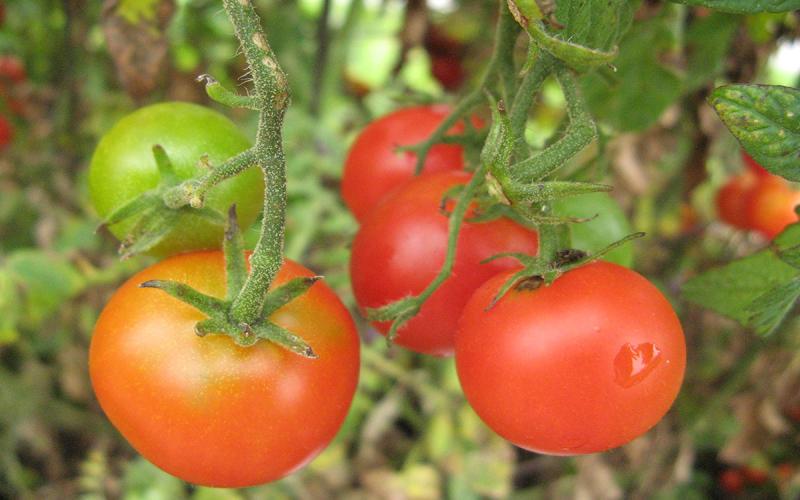
General Description: Tomatoes are one of the most popular vegetables for gardeners, being easy to grow in containers or in the ground. Home-grown tomatoes can offer superb flavor and texture since they don’t have to withstand shipping or long periods of storage.
Varieties: Ripe tomatoes may be red, yellow, pink, purplish-black, white or even green, depending on the variety, and they may be as small as blueberries or as large as grapefruit. Currant and grape tomatoes are the smallest tomatoes, borne on and usually harvested as a cluster, stem and all. Cherry tomatoes are a bit larger, more tender and usually harvested singly (Figure 1). Beefsteak are the extra-large tomatoes, usually sliced. Roma tomatoes, also known as Plum tomatoes, have thicker walls and less juice, so they are excellent for sauces.
Tomato Types
Determinate: Determinate tomatoes are great for canning, as they produce all their fruit in a short period of time. These tomatoes, also called “bush” tomatoes, stop growing once they set fruit. Determinate tomato plants tend to be shorter, so they don’t usually need staking, and they work well for containers (some are even called “patio” hybrids).
Indeterminate: If you are looking for a steady supply of tomatoes all season long, choose indeterminate varieties. They will keep growing and producing fruit until frost. Indeterminate types need to be staked or caged for support. Some varieties are called semi-determinate; as the name suggests, their growth habit is intermediate between determinate and indeterminate types. Check the label on your transplant or seed package; it should tell you whether the variety is determinate (bush) or indeterminate.
Planting

Timeline: Tomatoes are not frost-tolerant, and they do best in temperatures above 50°F, so wait to plant them outdoors until late spring or early summer (Figure 2), after the last frost date in your area, unless you are using wall-of-waters (plastic tubes filled with water) or other techniques to protect them from frost and cold.
Site Selection: Like most vegetables, tomatoes need eight hours of sun per day. Tomatoes will grow in nearly all types of soils. However, a light, well-drained, fertile soil high in organic matter is best for producing early, high-quality fruit. Do not plant where related crops, such as peppers, eggplant or tomatoes, were planted the previous year.
Transplants: Most tomatoes in South Dakota are grown from transplants. Transplants ideally should be five-to-six-weeks old (six-to-eight-inches tall) and, at most, just beginning to flower. Plants should be stocky, disease free and have dark-green leaves. Avoid root-bound plants. If you transplant a plant with fruit already on it, you may be the first one in the neighborhood to get a ripe tomato, but the subsequent yield of that plant may be reduced.
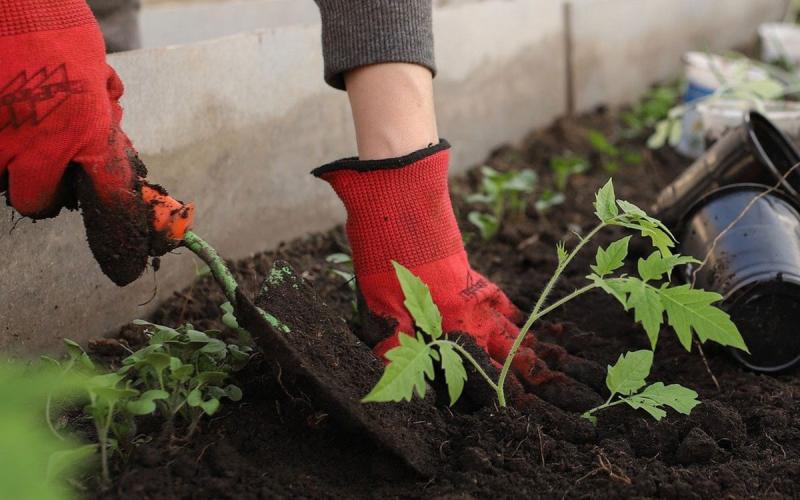
Harden off plants for one-to-two weeks before setting them into the garden. Leave the plants outside in a shady location at first, then gradually increase the amount of sunlight to full sun over a few days. It is also helpful to gradually expose them to increasing wind during the hardening process. If temperatures drop below 45°F, bring the plants indoors.
When transplanting, bury the tomato plants up to the first leaf (Figure 3). If the plants get too tall (leggy) before planting, lay them slanted along a five-to-six-inch deep furrow, cover half to three fourths of the stem with soil, and leave the top of the plant exposed. The plants will root all along the stem. Water well to settle the soil. Using a diluted starter fertilizer (high in phosphorous) solution for this purpose will help their roots to grow quickly in their new soil.
Distance between plants depends on the type of tomato, (indeterminate, see above, need more space), method of growing (on the ground, in cages or staked), fertility of the soil and the growing season. Many gardeners plant tomatoes in 3-foot rows with plants 2-to-3 feet apart within the row, and 4-to-6 feet between rows. Generous spacing will help decrease diseases.
Plant Care
Watering: You will need to adequately moisten the entire root zone of fully-grown tomato plants with at least one inch of water each week (depending on local soil, temperatures, wind and rainfall). Check to see that the water is penetrating deep into the soil (eight to ten inches). A light application of water every day or two may not adequately moisten the entire root zone and will encourage shallow rooting and increase stress-related problems, including blossom end rot (see below).
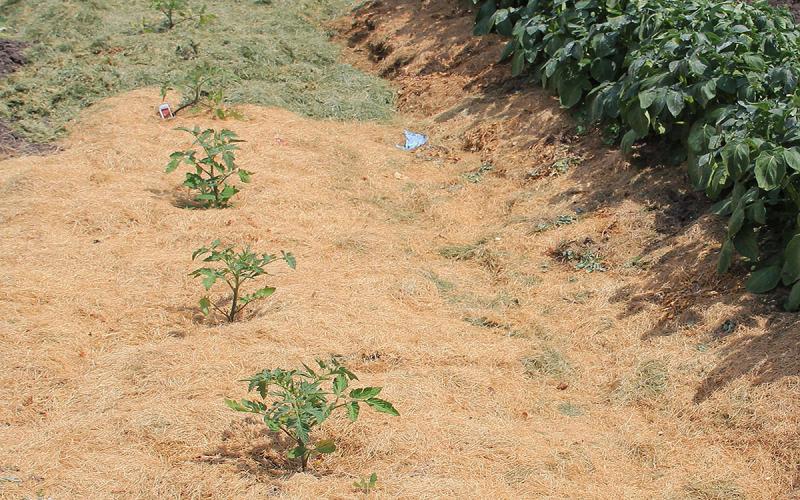
Mulching: Mulch may be used to warm or cool the soil, decrease weeds, conserve water and protect the plants from soil-borne diseases. Red or black plastic will increase soil temperatures and inhibit weed growth. Lay it on the ground a few days prior to planting to warm the soil. If you use an organic mulch instead of plastic, make sure the soil is moist and thoroughly warmed before applying. Straw mulch may help repel certain aphids and thrips and attract spiders that eat troublesome insect pests. Most organic mulch should be about two-and-a-half to three inches deep, otherwise, light will penetrate and weeds will come through. If the mulch compacts easily, as fresh lawn clippings do, it should be only half to one inch deep (Figure 4).
Fertilizing: Often, soil tests in South Dakota indicate a need only for nitrogen. In that case, a lawn fertilizer such as 26-0-0 (be sure it is not a “weed and feed” product, which also contains herbicide) can be used, at a rate of about ¼ pound (4 oz.) per 100 square feet.
Watch for nitrogen-deficiency symptoms when plants are about one foot tall and have started to flower. If the plants are light green or the lower leaves become yellow but otherwise seem healthy, they are likely nitrogen deficient, and a small amount of fertilizer will be helpful. Apply about 1 tablespoon of urea (46-0-0) per plant. You can also use a lawn fertilizer, such as a 27-3-3 (be sure it contains no herbicide!). Organic sources, such as fish emulsion may also be used. Apply the fertilizer in a circle around the plant, staying about 6 inches away from the stem, and water to move it into the soil. The tomato plant uses extra nitrogen when the fruit is just starting to ripen. Unless you suspect there is already too much nitrogen present, apply one tablespoon of nitrogen fertilizer again (as described above) per medium-sized plant after the first fruits begin to redden. This extra nitrogen may increase fruit size at harvest.
Note: Don’t apply too much nitrogen! If the tomato leaves are very dark, almost black-green, it may mean there is too much nitrogen in the soil. Excess nitrogen can lead to lush vegetative growth, but little fruit. The fruit may take longer to ripen and may not have the desired flavor. Too much nitrogen may also increase the amount of blossom end rot on the fruit (see below).
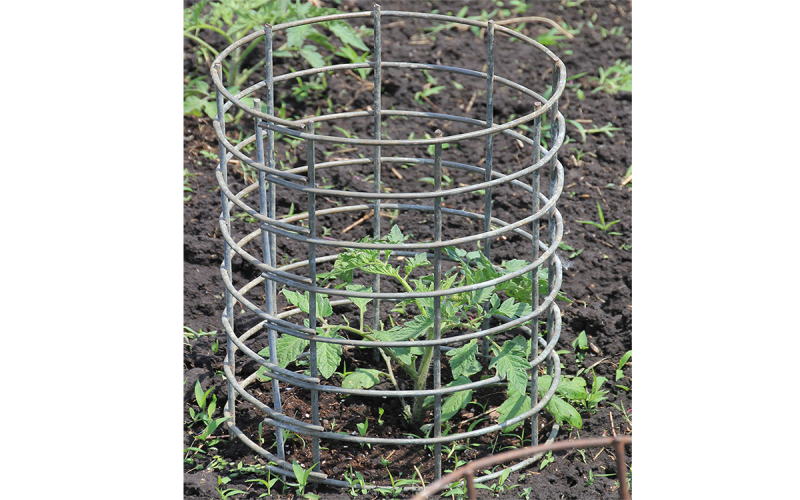
Staking and Pruning: Staking or caging, especially larger indeterminate plants, reduces rot and helps decrease leaf blights, and the fruits are generally larger, cleaner, ripen earlier, and are easier to harvest.
Generally, no pruning is needed for determinate types of tomatoes. Depending on the vigor of the variety, they may be grown either without support, staked or in cages.
Indeterminate types of tomatoes can be pruned to one or two stems and tied directly to stakes or twine strung between stakes. To prune, remove all suckers up to the one immediately below the first flower cluster.
An alternative to staking is the use of tomato cages), which decrease the need for pruning. Cages or stakes must be large enough and sturdy enough to support a heavy plant laden with fruit (Figure 5).
Diseases and Disorders
Common Disorders
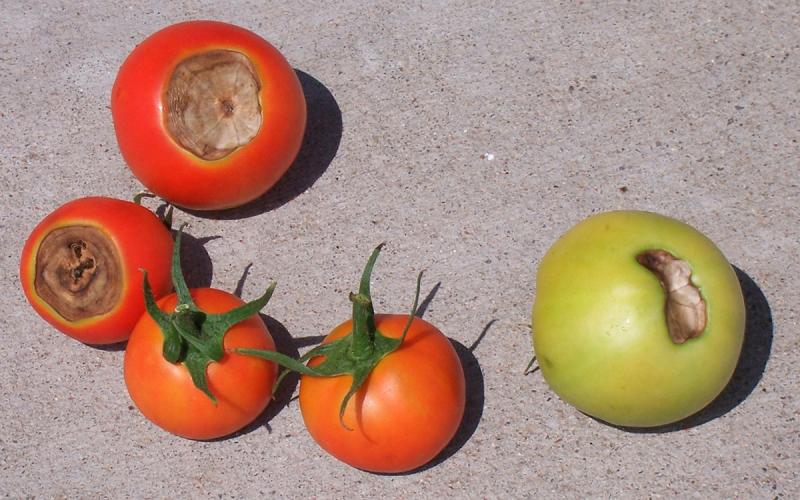
Blossom End Rot: One of the most-frequent tomato problems home gardeners observe is a dry, brown to black, leathery, scale-like blemish on bottom of the fruit (Figure 6). This is blossom end rot and is caused not by a disease, but by an inability of the plant to supply enough calcium to the developing fruit. The disorder is more common early in the season. Adding calcium to the soil will not help, as calcium is not usually deficient in South Dakota soils; rather, the problem is that roots are unable to absorb it quickly enough or distribute it uniformly. An exception to this is plants that are grown in a potting soil in containers; these may need to be supplemented with calcium, since potting soils may not have enough. Determinate types may be more susceptible, since all the fruit sets at once. Using a mulch around the plant can help even out the moisture levels in the soil and help facilitate calcium uptake to decrease this problem, as well as helping to reduce cracking and splitting of the fruit. Apply enough water at a time so that it penetrates deeply. During hot, windy periods, gardens may need to be watered several times a week. Containers may need to be watered daily.
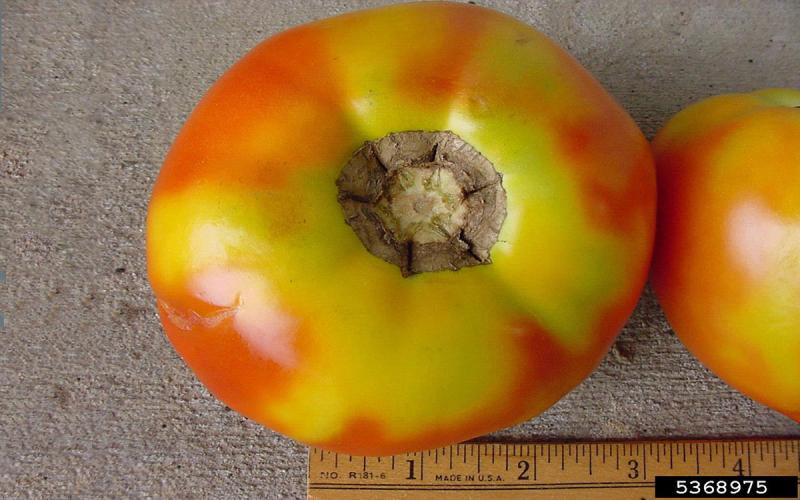
High Temperature Damage: At temperatures above 95°F, the fruit does not increase in size and will not color properly, often showing yellow “shoulders” (Figure 7). Also, at these high temperatures, the blossoms may fall off rather than producing fruit.
Common Diseases
Septoria: Leaves develop small, numerous, dark leaf spots that frequently have white or gray centers, but the fruit is not affected (Figure 8).
Early Blight: Leaf spots are larger and darker than those of Septoria, and they often exhibit a target pattern, formed of concentric rings of dried tissue (Figure 9-A). Early blight causes a somewhat leathery fruit rot, which usually starts at the stem end, thus helping distinguish it from blossom end rot (Figure 9-B). The fruit rot may or may not have a target pattern.
Removing infected leaves will help slow progress of these diseases, as will keeping the foliage dry (Don’t sprinkler irrigate). Mulches will help decrease infections initiated from infected soil splashed onto the foliage, and good air circulation will decrease infections.
Tomato Spotted Wilt Virus (TSWV): TSWV is an occasional problem in South Dakota. Symptoms include concentric circles of color on the fruit (Figure 10). Leaves may have small brown circles with green centers, as well as a general bronzed tinge to the upper foliage. New shoots may turn brown and shrivel. The virus is transferred by thrips, tiny insects that thrive in hot, dry weather. Removing an infected plant is the only treatment. The affected fruit is not poisonous, but may not be very edible and should not be used in canning.
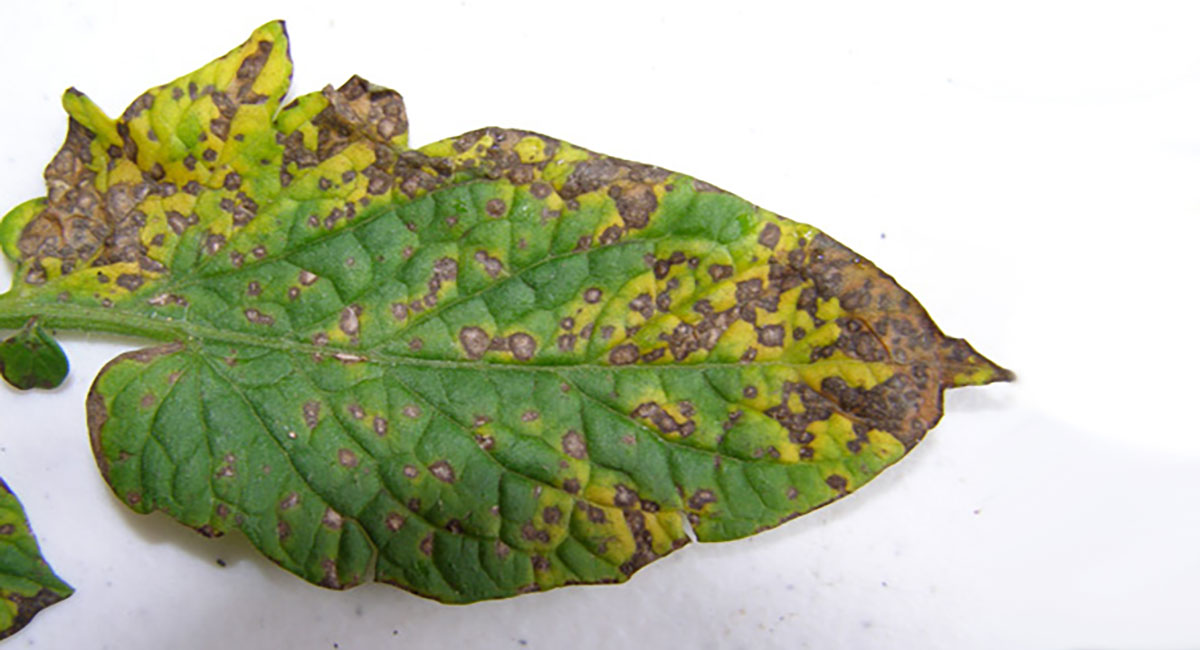

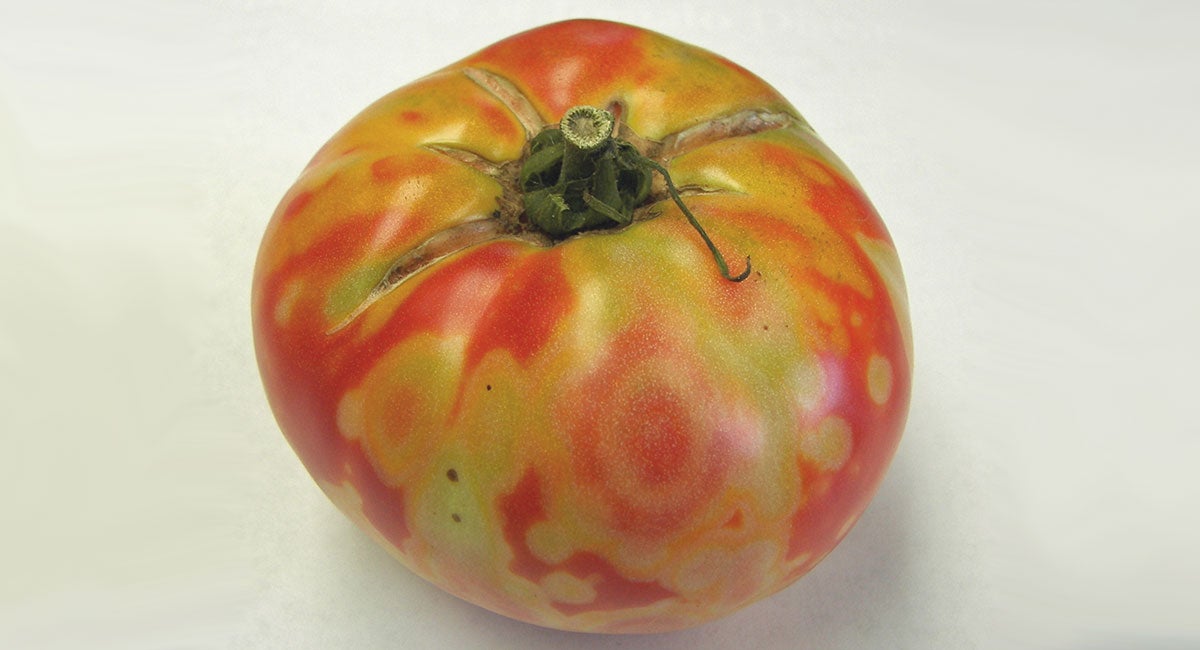
Harvest and Storage
Harvest: It takes about 30 days from bloom until the fruit is full-sized and begins to ripen. Tomatoes can be picked when they turn pink or light red, or they can be left on the plant until fully ripe.
Fruit on a frosted plant may be unsafe for canning. Chemical changes occur once the plant has been frosted, even if there are no signs of damage on the fruit. These chemical changes may reduce fruit acidity to a point where harmful bacteria may survive the canning process.
Average Yield: 10 to 20 pounds per plant.
Nutrition Facts: Tomatoes are a good source for potassium, vitamins B, C and E. They also contain lycopene and other antioxidants, which may help prevent cancer, decrease inflammation, keep your eyes and your heart healthier.
Storage: Picked fruit can be ripened inside the home or in a garage or basement. Place the fruit stem-side down on a layer of newspaper in a cool location. Cover with another layer of paper on top. Do not stack more than three layers of fruit. Store at about 60°F.
Do not place the fruit in a sunny window; this will shorten shelf life and delay ripening, and the fruit will often be damaged by the direct sun. Do not refrigerate tomatoes! The cold temperature will ruin the flavor and texture of the fruit.
Culinary Use: Tomatoes can be eaten fresh or cooked in many recipes. They can be preserved by freezing, canning or drying. For information on preparing or preserving tomatoes, see our Pick it! Try it! Like it! resource for tomatoes.
